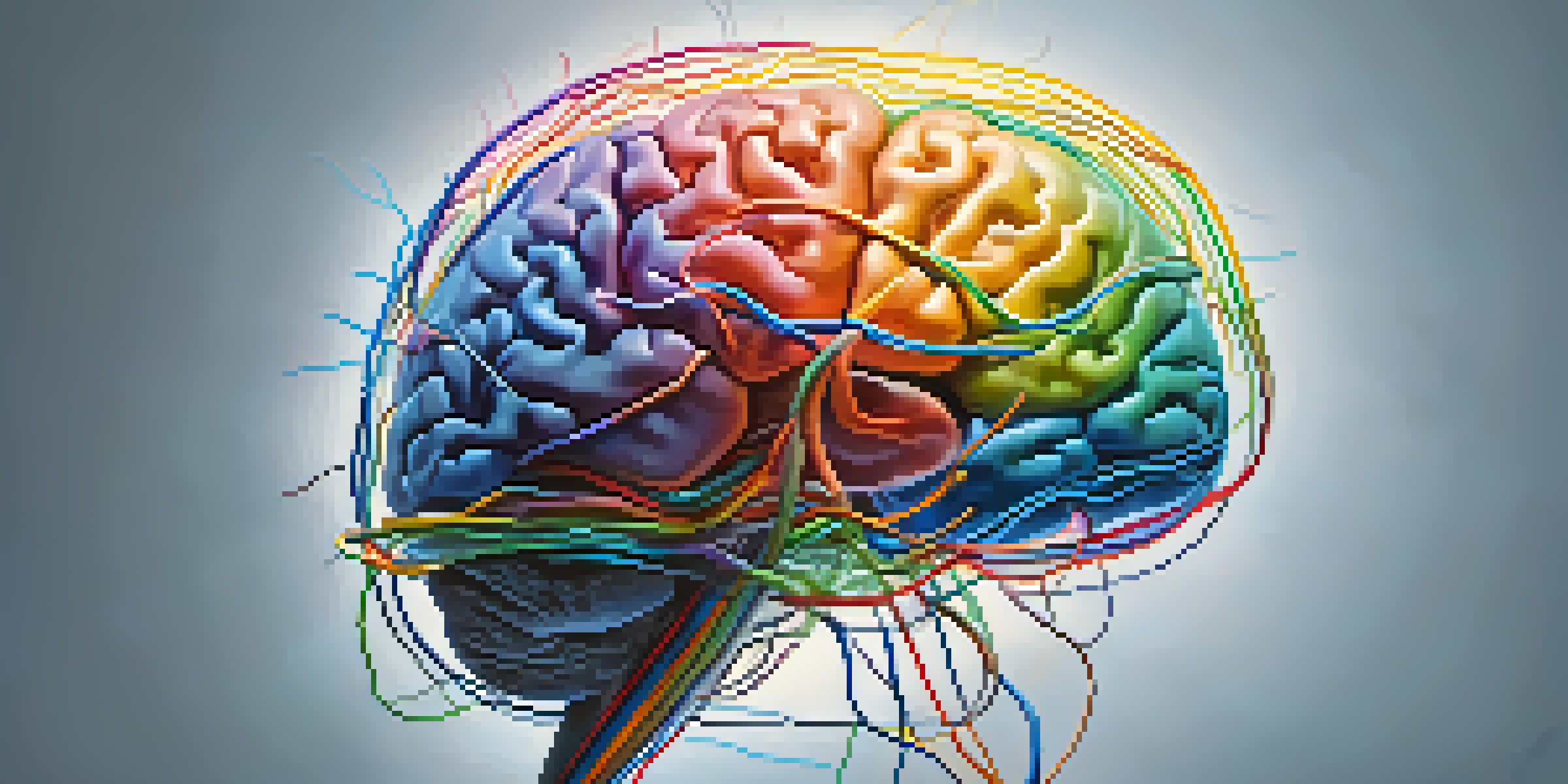Neuroplasticity: Healing and Growth Through Hallucinogens

Understanding Neuroplasticity: The Brain's Adaptable Nature
Neuroplasticity refers to the brain's remarkable ability to reorganize itself throughout life. This adaptability allows our brains to form new neural connections in response to learning, experience, and even injury. Think of it like a highway system; when one road is blocked, alternative routes can be established to reach the same destination. This process is crucial for recovery from trauma and for overall cognitive health.
The brain is a dynamic organ, capable of change and adaptation throughout life.
One of the most fascinating aspects of neuroplasticity is its role in healing. For example, after a stroke, the unaffected parts of the brain can often compensate for lost functions, helping patients regain abilities over time. This gives hope to those recovering from brain injuries or disorders, underscoring the importance of fostering an environment that promotes neuroplastic changes.
Moreover, neuroplasticity isn't just about recovery; it plays a significant role in personal growth and development. By engaging in new activities, learning new skills, or even practicing mindfulness, we can stimulate our brains to grow and adapt. This shows that we all have the potential for change, regardless of age or circumstance.
Hallucinogens: A Brief Overview and Their Historical Context
Hallucinogens, often associated with altered states of consciousness, have a long history of use in various cultures for spiritual and healing purposes. Substances like psilocybin mushrooms and LSD have been utilized for centuries, primarily in rituals and therapeutic settings. Recently, they have resurfaced in scientific research, revealing their potential to influence brain function profoundly.

These substances work primarily by interacting with serotonin receptors in the brain, which can lead to altered perceptions, emotions, and cognitive processes. Some studies suggest that these changes can foster a unique state of consciousness, allowing individuals to confront and process traumatic experiences. This opens a door to not only understanding oneself better but also healing from past wounds.
Neuroplasticity's Healing Power
Neuroplasticity enables the brain to reorganize and form new connections, crucial for recovery from trauma and cognitive health.
Interestingly, the revival of interest in hallucinogens coincides with a growing recognition of mental health issues in modern society. As traditional treatments often fall short, researchers are exploring how these substances can complement therapeutic practices, offering new hope for those struggling with conditions like depression, anxiety, and PTSD.
The Link Between Hallucinogens and Neuroplasticity Explained
Research indicates that hallucinogens may enhance neuroplasticity, promoting the formation of new neural pathways. This effect can be particularly beneficial for individuals dealing with trauma or mental health conditions, as it may help them reframe negative thought patterns. By creating new connections in the brain, hallucinogens can facilitate a fresh perspective on old problems.
Psychedelics can help us understand our minds and provide a powerful tool for healing.
For instance, studies have shown that psilocybin can promote synaptogenesis—the formation of new synapses—potentially leading to lasting changes in mood and cognition. This means that individuals may not only experience temporary relief but also undergo meaningful, long-term transformations. It's as if these substances act as a catalyst, speeding up the natural healing process of the brain.
Moreover, the experience of using hallucinogens often leads to a sense of connectedness and introspection, which can further enhance their therapeutic effects. This combination of neurochemical changes and meaningful personal experiences can create a powerful environment for healing and growth.
Scientific Studies: Evidence Supporting Hallucinogens' Benefits
A growing body of research supports the idea that hallucinogens can play a significant role in mental health treatment. For example, clinical trials have shown that psilocybin therapy can lead to significant reductions in depression and anxiety, particularly in individuals facing terminal illness. These studies highlight not only the immediate benefits but also the lasting impacts on patients' mental well-being.
Another notable study involved MDMA-assisted therapy for PTSD, showing that participants experienced remarkable improvements in symptoms after just a few sessions. The combination of the drug's effects and therapeutic support can create a safe space for individuals to confront painful memories, facilitating healing through neuroplastic changes.
Hallucinogens Enhance Neuroplasticity
Research shows that hallucinogens can promote neuroplasticity, aiding individuals in reframing negative thought patterns and fostering healing.
These findings are encouraging and suggest that hallucinogens could be integrated into conventional treatment protocols. However, further research is essential to fully understand their mechanisms and to develop safe, effective therapeutic frameworks.
Therapeutic Applications: How Hallucinogens Are Used in Practice
In therapeutic settings, hallucinogens are often administered alongside psychotherapy to maximize their healing potential. This approach allows patients to explore their emotions and experiences in a guided environment, enhancing the therapeutic process. It's like having a skilled navigator while sailing through uncharted waters—someone to help guide you through the experience.
For example, in a typical session, a patient might take a carefully monitored dose of psilocybin and then engage in talk therapy, allowing the insights gained during the experience to inform their healing journey. This holistic approach can lead to breakthroughs in understanding oneself and addressing deep-seated issues.
The integration of hallucinogens into therapy is still in its infancy, but early results are promising. As more practitioners adopt this approach, it's likely we'll see a shift in how mental health care is delivered, with a focus on personalized and innovative solutions.
Potential Risks and Ethical Considerations in Use
While the potential benefits of hallucinogens are exciting, it's crucial to acknowledge the risks involved. Not everyone will respond positively to these substances; some may experience adverse reactions or exacerbation of symptoms. This highlights the importance of conducting such therapies in controlled, supervised environments to ensure patient safety and support.
Moreover, ethical considerations arise in the context of informed consent and accessibility. As these treatments become more mainstream, it’s vital to ensure that patients are fully informed about what to expect and that access to such therapies is equitable. We don’t want to create a divide where only a select few can benefit from these advancements in mental health care.
Therapeutic Use of Hallucinogens
In therapy, hallucinogens are used alongside psychotherapy to facilitate emotional exploration and enhance healing processes.
Ultimately, a balanced approach that weighs the potential benefits against the risks is essential. Ongoing research and dialogue within the medical community will be key in navigating these challenges responsibly.
The Future of Neuroplasticity and Hallucinogen Research
The future of neuroplasticity and hallucinogen research holds a wealth of potential for transforming mental health treatment. As more studies emerge, we will gain deeper insights into how these substances can effectively facilitate healing and growth. This could lead to the development of new therapeutic models that integrate traditional psychology with innovative approaches using hallucinogens.
Moreover, as societal attitudes towards hallucinogens shift, there's an opportunity for broader acceptance and integration into mainstream healthcare. With ongoing advocacy and education, we could see a paradigm shift where mental health treatment is more holistic and personalized, addressing the unique needs of each individual.

In conclusion, the intersection of neuroplasticity and hallucinogens presents an exciting frontier in mental health research. With continued exploration, we might unlock new pathways to healing, ultimately leading to healthier, more resilient individuals.